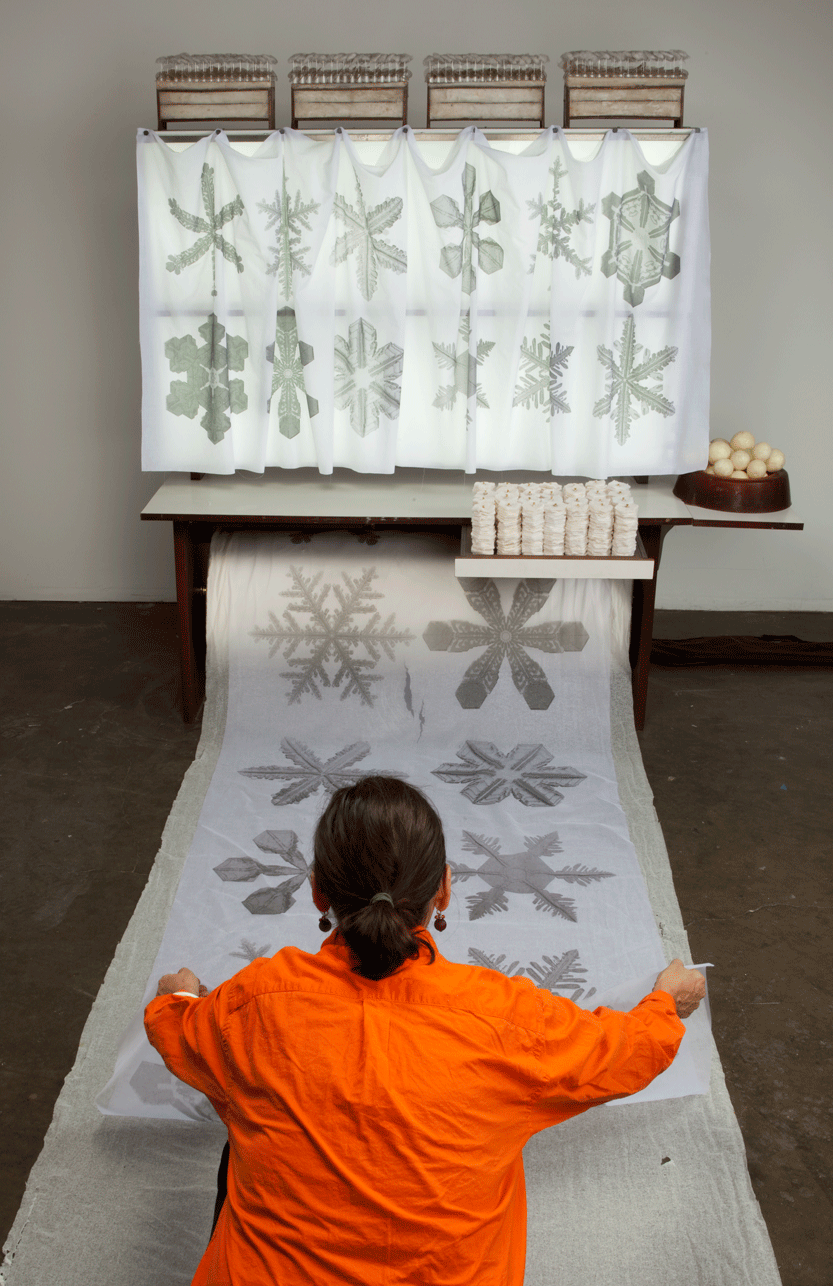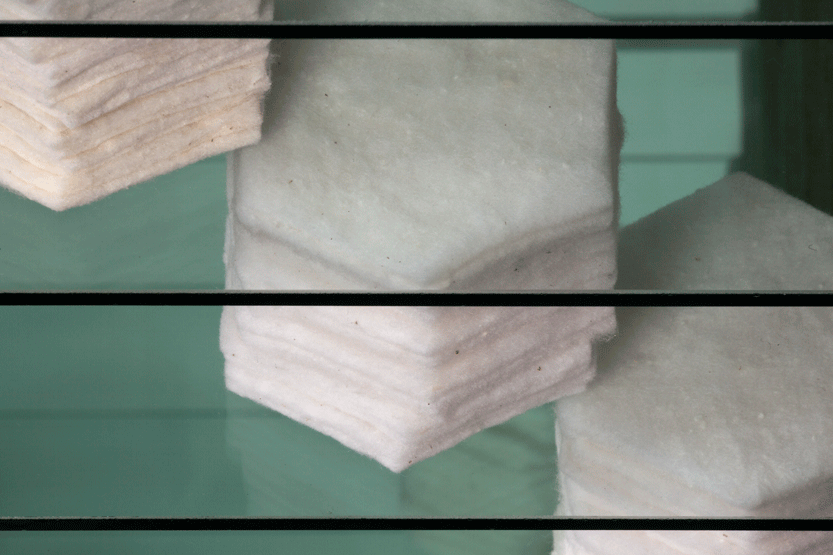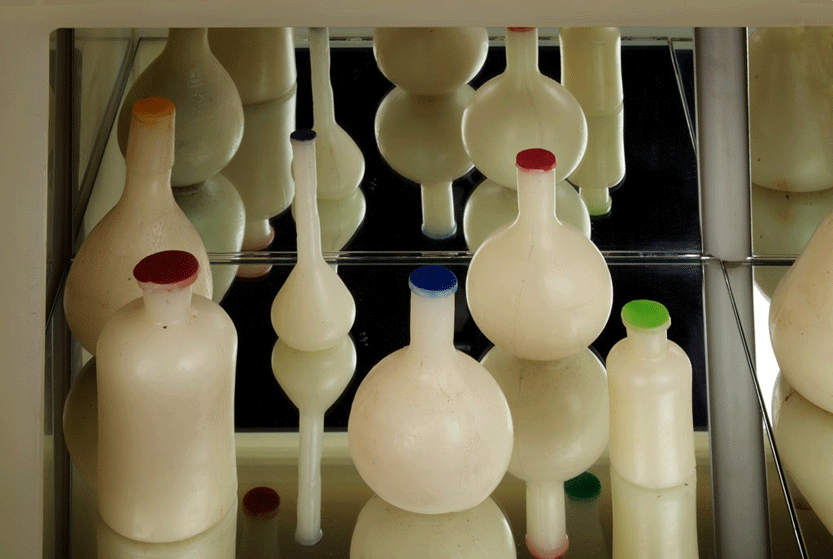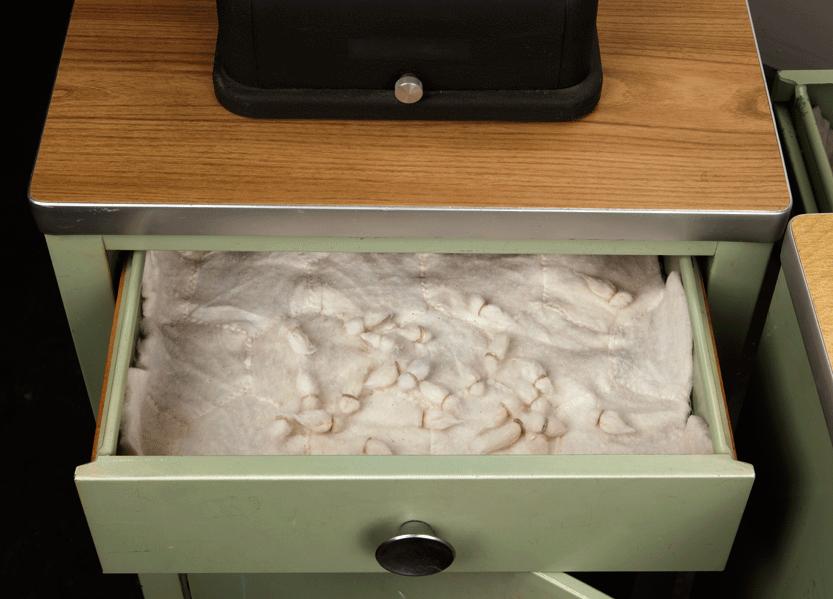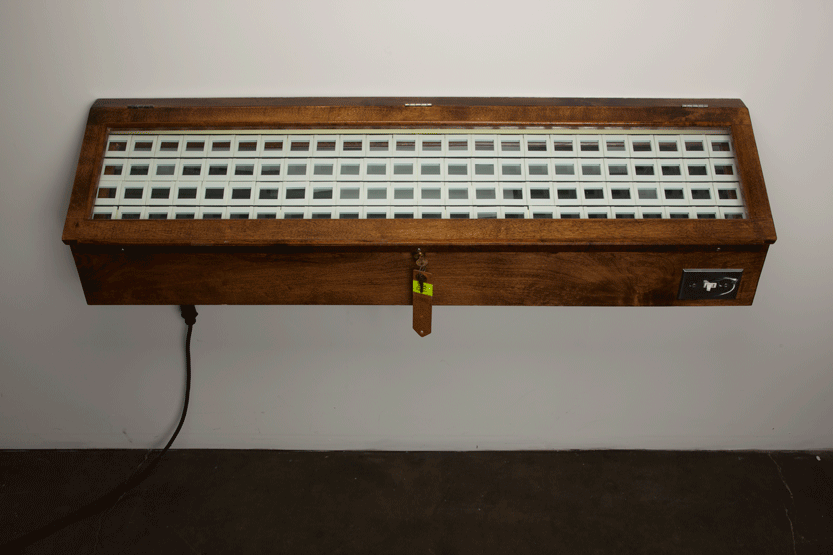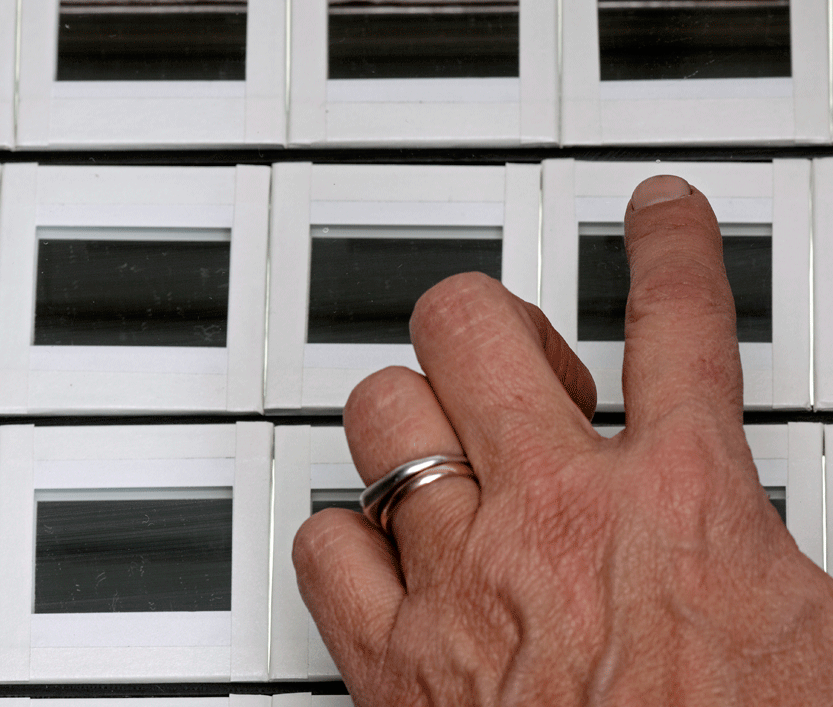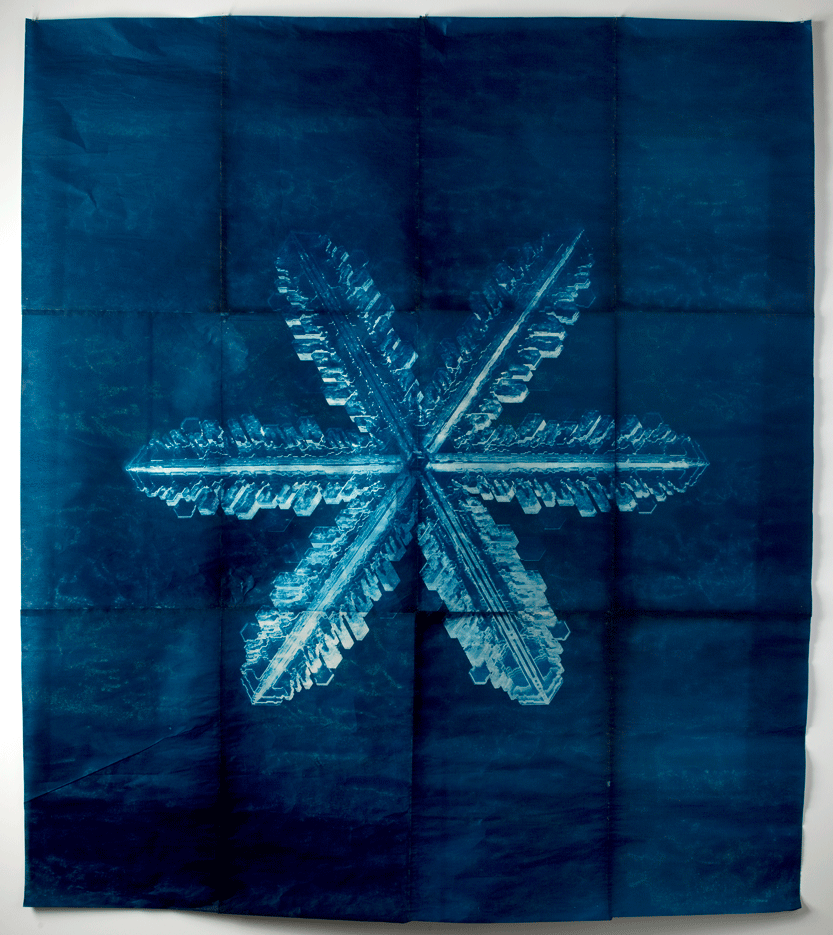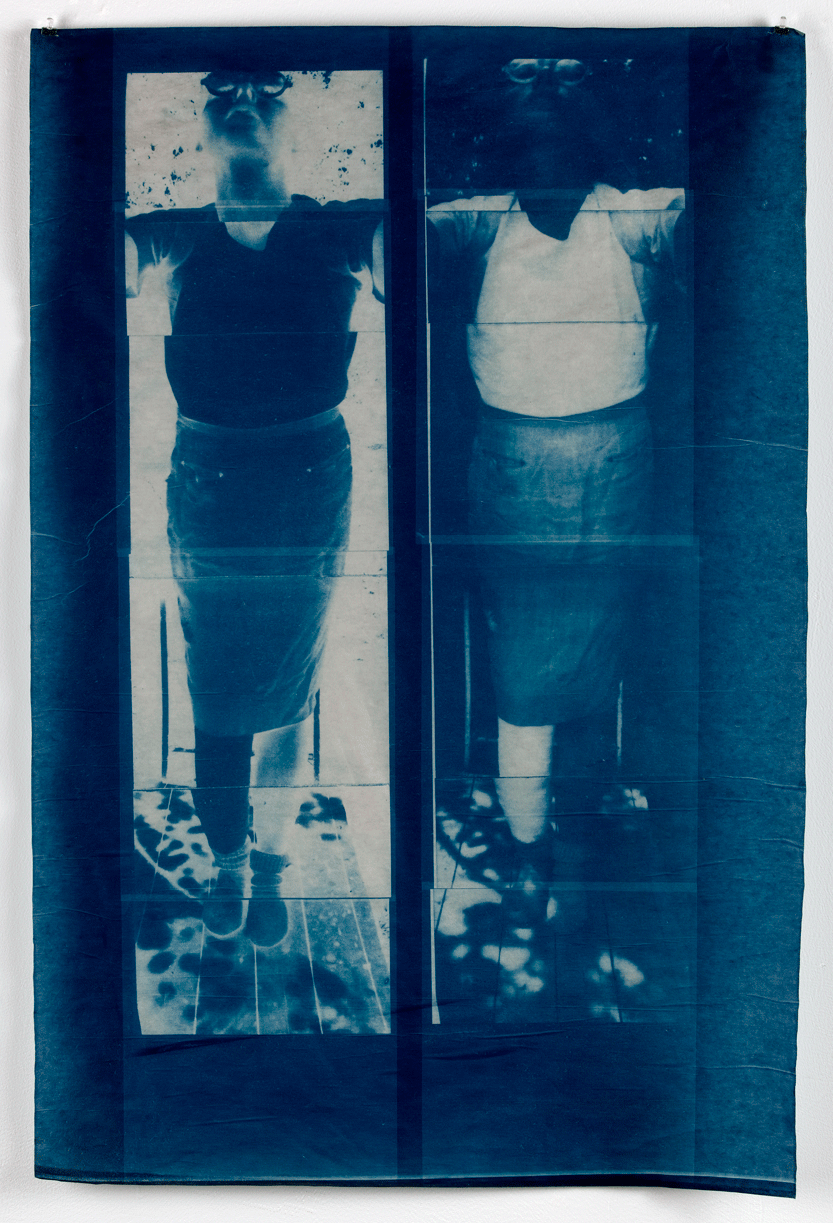Robin Hill: Case Discussions
January 13 - February 19, 2011
Lennon, Weinberg, Inc.
514 West 25 Street
New York, NY 10001
exhibition catalog
with essay by Kristin Koster
watch Andrew Sullivan reading his community generated poem: What's Happened to My Laboratory, which he organized in response to the work in the exhibition.
Collecting, Snowflakes, and the Case
The period, the region, the craftsmanship, the former ownership, for a true collector the whole background of an item adds up to a magic encyclopedia whose quintessence is the fate of his object.
– Walter Benjamin, Unpacking My Library
ROBIN HILL’S WORKS OF ART have long established her creative process as one that resists predictable equations between the maker and the made. With materials that vary in every new series, and include blue plaster castings of Dixie cups, hospital gurneys, opalescent mica washers, Pasteur Pipets, anda mathematical formula’s yield of snowflake, it is Hill’s intuition for recovery, compilation, and transformation—over any particular technique or stylized treatment of a medium—that distinguishes her .While her choices of material reveal an attentiveness to everyday cast offs and cultural detritus (see her orange peel installations, plastic bag cyanotypes, and office-furniture sound collage), the artist’s intervention is less a labor of repurposing, than a quasi- mystical libratory act. She releases her objects to processes (of exposure, of gravity, of multiplication and mathematical calculation), that allow for their re-emergence in new forms, new sizes, and new configurations. Compared to the aesthetics of the artist-recycler, ragpicker, or gleaner, there is a deliberation and a type of precision in her object-choices: her finished pieces, whether installations, drawings, or sculpture, show no traces of having been “rejected” but seem to shimmer, instead, in the glow of finally being seen. Both discerning in her choices, and open to the hazard of dérive, Hill might best be described as a kind of surrealist project manager, a flâneur on the factory floor, a choreographer of the barely visible.
It is hard to imagine theorizing Hill’s work without evoking the great critic and cataloguer of 19th-century French culture,Walter Benjamin, who drew on the figures of the flâneur, the collector, the gleaner, and the ragpicker (or chiffonier)1 as types that exposed the changed position of the artist and his relation to material culture in the emergent, urban landscape of modernity. Gleaners, ragpickers, and chiffoniers were, in 19th-century Paris, part of the new, urban poor who depended on the leftovers of material production to make their livings, feed their families, and support their habits.They became visible as one of the countless paradoxes of modern life: to the illusion of plenty, they provided the proof of unmet need and over accumulation; to the fiction of social mobility, they delimited the lowest ladder rungs necessary for the petty bourgeois’ ascent.Their ubiquitous presence on the boulevards and in the panorama of everyday life made themes of consumption and material accumulation central for artists and poets who recognized themselves as the gleaners, ragpickers, and, chiffoniers of an era overburdened by images, information, and sensation.
Among these central 19th century figures, Benjamin also counted the “collector” who was similar to the ragpicker or chiffonier in his orientation toward over- looked material, but differed in his object-choices and his motivations for recovery. And it is perhaps here, in the Benjaminian figure of the collector, where we find the best correlation to Hill, and the import of her prescience and artistic process. Benjamin explained that the collector differed from the ragpicker or gleaner, chiefly because he amassed overlooked or rejected materials out of pleasure
1 Chiffonier is French for ‘ragpicker’, and though the word now connotes a piece of furniture (usually a sideboard), its origin suggests that, as furniture, it was intended as a receptacle for odds and ends which had no other place.opposed to necessity.
Benjamin compared the collector’s passion to that of the child, for whom objects are not yet commodities, and have no necessary use value. Only the child, and perhaps the very rich (who already had everything they needed), could be counted on to collect objects without regard for their material value. Instead, their choices were based on instinct, whim, and the “disinterested delight” that Kant considered necessary for the recognition of the truly beautiful.
Their collections, blind to categories, and indifferent to re-sale value, could be considered rare repositories of the “good-for-nothing”. In this sense, Benjamin considered the process of collecting, and the work of the collector, revolutionary; the collector released his objects from the drudgery of useful- ness, so that instead of being a means to an end, they were freed to become ends in themselves.The collector’s fascination with them was never nostalgic: it was an obsession for their identities, their details and their qualities qua objects—and so his desire to preserve, catalogue, and identify them, could appear to verge on the fetishistic.Yet in this refusal to translate his objects into value, and in their liberation from use, the collector transformed them, for the first time perhaps, into themselves. The historian in Benjamin recognized the redemptive value of collecting: if the history of capitalism was a history of objects and labour as value, then the act of collecting useless objects salvaged a part of history that would otherwise fall out of that narrative. In preserving the useless, the collector intervened in history, redeemed the present, and enabled a fuller, more comprehensive expression of his time. Today, amid a vast cadre of artists who reuse, recycle, or re-purpose the cast away materials that populate their environments, Hill stands apart as a dis- interested collector, and as a kind of aristocratic flâneur of the everyday. She doesn’t choose her objects to make a point about over-production or excess, and so ends up intervening in the collector’s singular, historical way. And her process of making, which can be read against the imperative to produce, separates her further. She never makes use, cycles, or purpose: instead she makes visible, resurrects, and liberates.
Hill’s instinct for locating excess, in fact, has never been restricted to the realm of physical matter. Understanding that over-accumulation is as prevalent in the image and computer-driven computation as it is in material, Hill is just as likely to seize on sunlight (famously implicated in the over-production of the image, by Baudelaire, through the photograph) or the dizzying multiplication of a mathematical formula, as she is to salvage a slide carousel or a mica chip. In the materials she does settle upon, and the trajectory they take toward visibility, we invariably discover (hear, read, touch, or observe) the moribund captives of our day—revealed, exhumed, palpitating, set free.
In Hill’s delight over what she refers to as her “cullings,” 2 we witness the true collector’s commitment to detail and her singular intuition for discovery. For her current exhibition, Case Discussions, Hill salvaged the majority of her materials from the University of California, Davis’ Bargain Barn: a practical cemetery for the university’s research labs, where outmoded equipment is sold off at cut-rate prices.What she acquired from the storehouse of obsolete items includes a Micro Scan microfiche viewer, a Darkfield Quebec colony counter, a steel audio-visual cart, test tube racks, a nuARC light table, and an assortment of Pasteur Pipets.True to the collectors’ obsessive attention to her finds, Hill set out to research and recreate the customized accessories of her treasures’ pasts.
To construct The Where House, a six-foot steel rack flanked with tiles of mirrored glass, slid into stainless steel cage tag holders, Hill embarked on a journey of rigorous investigation and identification. “After finding these tag holders, I still had to figure out what they were,” Hill explains, “You have no idea how hard they were to find: my friend Patty Pesavento, a UC Davis veterinarian, gave them to me. I found out that they were cage tag holders for lab rats and mice that come from a company in Cincinnati called ‘Alternative Designs,’ where all they do is make architecture for lab rats and mice-- That’s all they do!” Triumphant, Hill commissioned an order of 100 of the tag holders, into which she inserted mirrored panels, then hung from the outside of the rack. On the interior of The Where House, where thirteen highly-reflective glass shelves are slid onto the tracks (think of the racks you put your food trays on after finishing lunch at IKEA, and you’ll be on target), Hill arranged stacks of cotton batting that she dumpster-dove from a defunct shoulder pad manufacturing factory in Brooklyn, NY.This cloud-like, unbleached batting, once destined as the hidden architecture of garments, is now revealed, and becomes central to a number of works in the same exhibition. Cut into flat, hexagonal wafers, stacked, and arranged in a helix descending the shelves, the batting reads like a spiral staircase connecting the endless levels of an industrial dollhouse.
Like many of her pieces, The Where House brings together a number of discrete, seemingly unrelated objects that, once united, reveal the magic of a wholly new historical configuration.Their re-emergence in the artist’s studio—where they are most fully themselves, and vibrate in surprising relationships to each other—is the serendipity that shakes unexpected insight free. During a recent studio visit, UC Davis Mathematician, Janko Gravner, mused that The Where House is reminiscent of Marcel Duchamp’s cubist masterpiece Nude Descending a Staircase, only with snowflakes.
2 The word ‘culling’ is derived from the Latin, colligere, which means ‘to collect’. If today we think of a collection as an ensemble of categorically similar objects with elevated worth, it is interesting to note that at its origin, the cull, or collection, designated the set of items rejected during the sorting process.This distinction underscores the lost implication of ‘uselessness’ in collecting.
And because distance, when it snows, leads no longer out into the world but within, so Baghdad and Babylon, Acre and Alaska,Tromsö and Transvaal were places within me.
–Walter Benjamin, Berlin Childhood Around 1900
AND IT IS JUST THIS TYPE OF CONNECTION—where a viewer can substitute an ice crystal for a nude—that Hill’s highly collaborative, intuitive process of creation affords. As a city-dweller displaced into a small university town, she crosses disciplinary boundaries like a flâneur on an urban stroll: collecting new approaches, insights, and technologies from scientists, veteri- narians, and theorists. Last year, in her “Snowflakes” project, Hill worked with Mathematics Professor, Janko Gravner, who is co-credited with developing the first virtual snowflake.3 Gravner’s three-dimensional algorithm for snow crystal evolution depends on a dizzying computational process, whereby he enters the formula for a possible snow crystal into a super computer, and then “grows” a snowflake in 24 hours. Hill, whose part was to create a visual representation of the digitized crystal, would take Gravner’s images, enlarge them a hundred fold, then expose and print them, using the 19th century cyanotype process. What resulted of this translation was a massive field of Prussian blue, with a ghostly, opalescent flake dangling in its sky. From the non-space of cloud computing, Hill produces a singular image that brings us nearer to the weather than we’ve ever stood.
The scale of the flake, and our invitation to stare into its crystalline dendrites, that hover “right on the edge of feasibility,” are what Hill, as an artist, aspires to offer: “Physically, I am trying to transform little things into bigger things, shape, nuance, and relocate familiar things in an unfamiliar order. I hope to awaken in the viewer a feeling of familiarity and distance, resourcefulness and impracticality, and maybe even inspire a willingness to see a molehill as a mountain, to shift ones perception to embrace small as big, simple as complex, ordinary as elegant, low-end as high-end, easy as difficult, accidental as purposeful, incidental as noteworthy.”4
Hill’s theories concerning the objects recovered for her current body of work, Case Discussions, foreground the creation of space and alternative economies of perception. She explains: 5 “I don’t work with found objects with any sort of nostalgia for the objects. I’m interested in the integrity they have on their own. I take these things and treat them like architectural spaces that are very finely crafted.” And so once her materials surround her in her studio, Case Discussions begins to take shape as a kind of construction project. As she builds, it is increasingly clear that her pieces are related, thematically, by perspective, display, and by the illusion of excess space, where actually there is none.
As a maker, Hill has long claimed that she has no desire to put more “stuff ” into the world; and she now embarks upon the project that will read as a meta-commentary on her artistic credo. Consider, for example, Dot Transport Cabinet, for Mary, named for the late painter, Mary Hambleton: a two- tiered chemical transport cabinet, with a crowd of wax bottles populating its reflective surfaces.With each shelf mirrored on top and bottom, and a mirrored wall dividing the cabinet, the bottles redouble, and even appear, from a distance, glued onto the top shelves upside down—their thin necks like stalactites hanging from the cabinet’s roof. Hill explains that this piece, in particular, achieves the economy of image she strives to configure: “It shows a spatial economy.The economy of mirroring is that you’re actually creating more of something without making more: you’re creating more though amplification and reflection.” 6 Again, in the light-box piece entitled You, Hill replaces ninety-six transparent slides in a disused art department display case with ninety-six mirrors. In place of looking through a selection of art history images on slides, the mirrors bounce one single image—the viewer’s gaze— back out to her.
But if Hill is experimenting with economies of perception and the creation of spaces that don’t physically exist, she does so by means of objects that hover on the threshold of visibility, themselves. Her materials are those things whose moments have come and gone, and like the snowflake or the flame, reveal themselves only in the glimmer of their extinction.What makes her current body of work so poignant is located in her object choices, each one of which is an instrument for viewing, examining, or observing, in an institution where she teaches visual arts.When she dredges the leftovers of the UC Davis Bargain Barn, she doesn’t only cull the obsolete materials from research labs, she memorializes the public research institution, and the relationship that per- ception once had there to education. In the university today, the microfiche readers, slide carousels, projectors, display cases, and lenses have been replaced by computer screens and virtual labor.Where one used to observe, magnify and experiment through glass plates and lenses, there are now opaque screens, whose surfaces reflect, mirror, and return the gaze. As these surfaces foreclose on transparency, there is little option for viewing but as reflection and illusion.
WHAT MAKES HILL A COLLECTOR in the true Benjaminian sense, is that her pieces, once together in their newest constellation, point beyond themselves (as detritus), and even beyond the transformation of education and perception, to illuminate the historical conditions that, simply put, got them into this situation. During the period when Hill began compiling the collection that now makes up Case Discussions, northern California was fast becoming one of the nation’s ‘hot spots’ for housing foreclosures. At the same time, the Regents of the University of California implemented a stultifying program of tuition hikes, employee cut-backs, and departmental closures, that, understood as the last straw in the gradual privatization of public education, propelled many of Hill’s own students to the forefront of protests, demonstrations, and building occupations.Though it was never the artist’s intention, her collection can be read, by critics like this one, as gesturing toward the financial crisis of 2008, with its underlying connections to the loss of homes, futures, investments, and space.
Back again at The Where House we find it undeniably prescient that the artist has built a glass house out of university castaways that uses reflection to create an illusion of infinite space. If we consider the mortgage crisis and the subsequent loss of homes through foreclosures as a financial experiment (where the lab rats were people) then the title of the work—The Where House—suddenly changes inflection, and reveals it’s no pun or double entendre, but a question about where one will live, that now haunts millions.
As with any powerful dialectical image, The Where House both contains and reveals its contradictions. On the one hand, the endlessly spiraling staircase connecting its levels recalls the seemingly infinite proliferation of space in the new-home construction and consumption boom that artificially inflated the US economy for years. On the other, the semi-transparent, reflective surfaces, delimit the breaking points, or glass floor, of the entire structure. Beneathits mirrored panes, the flâneur and ragpicker both reappear: as one speculates on possible heights, the other sorts through cotton remains.The titles of the pieces in Hill’s present body of work reveal this same tension, which now, inscribed in print, will be harder to erase: Anticipated Accumulation, Looking into the Situation, Left Behind, and Slope all implicate a failed economic system, and its inability (over the same period that Hill has spent creating Case Discussions) to advance some tenable reform.
Even her cyanotype snowflake cannot help being read as a forecast of the weather, in the sense that Bob Dylan used the term, to indicate a radical change.The images she produces, after all, are made possible by a virtual process called “cloud computing,” developed during the same period in the US where the market for real estate finally ran dry. Cloud computing is advanced (online, of course), as a “natural evolution” of service-oriented architecture and utility computing, where computations too large for a single computer are run on “rented” real estate.The almost comical definition of cloud computing positions it squarely as an attempt to rationalize the only remaining market for real estate: virtual space. Here is Wikipedia explaining how labor (or computation) is distanced and made invisible in this virtual work: “Details are abstracted from consumers, who no longer have need for expertise in, or control over, the technology infrastructure “in the cloud” that supports them.” 7 We remember of course, that Hill’s cyanotype renderings re-inscribe detail, processing, and work on this mass of virtual vapour (or cloud) where her snowflakes grow. She manages visibility, and insists on its new space, by means of sunlight and illumination: the very conditions that would melt a true ice crystal away. Her snowflakes thus track the virtual that replaces the visible; they track the end of transparency; the opacity of clouds. And yet through them, there is this sky; this specter; this blue.
Hill, as a quintessential collector, has culled her objects and revealed through the care and showcasing of each one of them “a whole magical encyclopedia, a world order.” And though they find each other, like we do, at a moment of great uncertainty, they vibrate with a tremor full of life.Together as a collection, and finally—for the first time—themselves, they insist on the revelation that our shared moment in history—unique and dangerous in revolutionary potential—is both the situation, and the Case.
Kristin Koster
Davis, California
December 2010
1 Chiffonier is French for ‘ragpicker’, and though the word now connotes a piece of furniture (usually a sideboard), its origin suggests that, as furniture, it was intended as a receptacle for odds and ends which had no other place.opposed to necessity.
2 The word ‘culling’ is derived from the Latin, colligere, which means ‘to collect’. If today we think of a collection as an ensemble of categorically similar objects with elevated worth, it is interesting to note that at its origin, the cull, or collection, designated the set of items rejected during the sorting process.This distinction underscores the lost implication of ‘uselessness’ in collecting.
3 In January 2009, Janko Gravner of University of California, Davis, and David Griffeath of the University of Wisconsin-Madison co-designed the first successful three-dimensional computer model to replicate the wildly complex growth of snow crystals. resentation of the digitized crystal, would take Gravner’s images, enlarge them a hundred fold, then expose and print them, using the 19th century cyanotype process. What resulted of this translation was a massive field of Prussian blue, with a ghostly, opalescent flake dangling in its sky. From the non-space of cloud computing, Hill produces a singular image that brings us nearer to the weather than we’ve ever stood.
4 Extract from Hill’s ‘Artist’s Statement’ on her 2006 interactive installation with Samuel Nichols, Kardex.
5 From a conversation between the author and Robin Hill, at Hill’s studio in Woodland, CA, Dec. 2009.
6 Ibid.

